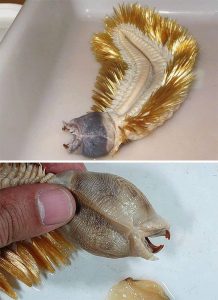A fascinating and eerie marine worm has recently exploded across social media, and once you lay eyes on it, you’ll immediately understand why. This strange creature, called Eulagisca gigantea, looks like it was plucked straight from a sci-fi horror film rather than the frigid depths of Antarctica’s icy waters. With its shimmering golden bristles and its wide, tooth-studded mouth, this worm could easily pass for some bizarre holiday ornament gone terribly wrong. Yet despite its eerie appearance, Eulagisca gigantea is very real and has been quietly existing in the cold Southern Ocean for decades. It’s only recently, thanks to the power of social media, that this bizarre sea worm has captured the world’s attention.

So, what exactly makes Eulagisca gigantea such a standout? To start with, it’s not your typical earthworm-sized critter. Measuring about eight inches long — roughly the size of a banana — it’s considerably large for a marine worm. But what’s truly jaw-dropping about it is its retractable throat, a feature that makes it one of the most unique predators lurking beneath the waves. When it’s time to feed, the worm can extend its throat outward, revealing a terrifying mouth lined with sharp teeth. This hunting adaptation allows Eulagisca gigantea to grasp and devour smaller marine animals. It’s a chilling reminder that even the most dazzling-looking creatures in the ocean can also be fearsome predators.
The golden bristles that make Eulagisca gigantea look almost decorative serve more than just a visual purpose. Scientists believe that these bristles, technically called chaetae, help the worm maneuver through the ocean environment. Whether swimming gracefully through the water, crawling along the ocean floor, or warding off predators, these shimmering spines play a crucial role in the worm’s survival strategy. However, it’s important to note that much about this species remains a mystery. Despite its discovery back in 1939, Eulagisca gigantea has only been studied sporadically, meaning that large gaps still exist in our understanding of its behavior, reproduction, and overall lifestyle.
This worm belongs to a broader group of creatures known as polychaete worms, which are a remarkably diverse category of marine invertebrates. Polychaetes are found throughout every corner of the world’s oceans, from vibrant shallow coral reefs to the pitch-black zones of deep-sea hydrothermal vents. They come in a breathtaking variety of shapes, colors, and sizes, with each species adapted to survive in its particular ecological niche. Today, scientists have identified over 8,000 species of polychaete worms. However, marine biologists suspect that many more have yet to be discovered. The ocean remains one of the least explored areas of our planet, and each new expedition brings the potential to encounter unknown and astonishing life forms.
A 2016 scientific study suggested that we might have only identified about half of all marine worm species currently inhabiting our oceans. This means that thousands of yet-unknown worm species could be waiting in the depths, hiding among shipwrecks, coral beds, or the remote trenches of the sea floor. Far from being mere curiosities, these worms play vital roles within marine ecosystems. They help cycle nutrients, break down organic matter, and even contribute to the complex food webs that sustain oceanic life. Their study offers valuable insights into biodiversity, evolutionary biology, and the intricate workings of deep-sea ecosystems.
The recent viral sensation surrounding Eulagisca gigantea began when an image of the worm, collected from Antarctic waters, was posted on Facebook. The photo, showcasing the worm’s dazzling metallic bristles and its fearsome, gaping jaws, quickly captured the internet’s imagination. Viewers were equal parts horrified and fascinated by the creature’s alien-like appearance. Comments ranged from disbelief to awe, with some users comparing it to nightmare fuel while others marveled at the raw beauty of life’s adaptability.
What makes viral moments like this so important is that they remind us of the incredible diversity and mystery that still thrives on our own planet. While science fiction often dreams up strange alien worlds teeming with bizarre creatures, the reality is that Earth’s oceans — especially the deep sea — are filled with life forms that are every bit as strange, if not stranger. Creatures like Eulagisca gigantea help underscore just how little we truly know about our own planet and how much there is still left to discover.
For marine biologists and oceanographers, every new discovery deepens our understanding of the complexities of underwater ecosystems. It sheds light on evolutionary processes that have shaped life under extreme conditions — from freezing temperatures to crushing pressures. By studying organisms like Eulagisca gigantea, scientists are piecing together the puzzle of how life not only survives but thrives in places where, until recently, we believed little could exist.
The Southern Ocean, surrounding Antarctica, is a place of incredible biological richness, despite its harsh environment. The creatures that live there have evolved astounding adaptations to the cold, dark, and nutrient-poor conditions. Eulagisca gigantea is just one striking example of nature’s ingenuity. It invites us to think more deeply about conservation, exploration, and the future of scientific research in our planet’s final frontiers.
As technology improves and deep-sea exploration becomes more accessible, we can expect even more astonishing discoveries. New species, stranger and more dazzling than we could ever imagine, are likely waiting just out of sight, nestled in the ocean’s hidden crannies. Each creature that surfaces from these depths tells a story — a story of survival, of evolution, and of the unending creativity of nature.
The next time you scroll past a viral photo of some bizarre sea creature, take a moment to appreciate not just its shocking appearance but the wonder it represents. Creatures like Eulagisca gigantea are living proof that our world is still full of secrets waiting to be uncovered, and that sometimes, reality is far stranger, far more thrilling, and far more beautiful than anything we could dream up in fiction.





